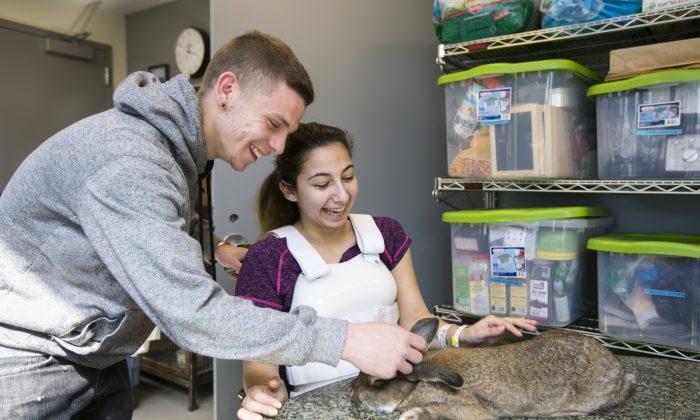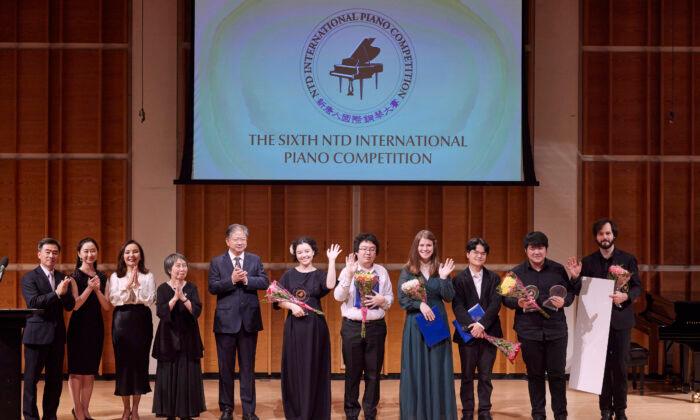NEW YORK—Finding yourself in need of rehabilitation services for a serious physical injury or illness is a daunting experience, but at NYU Langone Medical Center’s Rusk Rehabilitation, you can get extra special therapy—from bunnies.
That’s right—rabbits.
Patients pet the snuggly creatures or engage in therapeutic activities with them, and by the end of their session, some patients feel less pain than when they started out and even forget to ask for pain medication.
For about 15 years, bunnies have been part of the hospital’s horticultural therapy program, an adjunct clinical practice that helps patients forget about their troubles by connecting with nature. In some cases, patients’ rehabilitation seems to progress quicker than expected.
Resident bunnies Clovis and Nutmeg serve as companions and therapy buddies for patients suffering with brain injuries, strokes, orthopedic injuries, and spinal cord injuries.
The idea of adding the cuddly rabbits to the horticulture program was envisioned by manager Gwenn Fried, who has been working in the program for nearly 20 years.

“I mentioned it to my boss one time that rabbits would be a nice addition, and then went to a rescue and tried it out, and everyone loved them,” she said.
Fried recalled a stroke patient who was really depressed and needed some coaxing to get out of bed. After two days of bunny visits, the patient started to pet the animal.
“It was her way of coming back into the world,” Fried said.
Eventually the patient got out of bed to participate in therapy. She ended up being discharged home, “versus probably not getting through and her having to go to a subacute facility,” Fried said.
And petting bunnies is much more fun than a grueling hour of physical therapy (PT). That’s what patient Adriana Sparacino thinks. “PT makes you upset because you don’t want to be doing that, and it’s hard,” she said.

Sparacino has been a patient at NYU Langone’s Hospital for Joint Diseases since early March after suffering a spinal injury in a car accident.
Sparacino, 19, had only been there a few days when she discovered the bunnies on her way to the cafeteria.
“I remember I didn’t have an appetite, so my dad brought me up here to try to eat,” she said.
Ever since then, she has been asking to see the bunnies and said the staff also brings the bunnies to her room. Hanging out with Nutmeg (her favorite) makes Sparacino happy.
She said after spending time with the bunnies or planting some flowers, her pain seems to subside. “It’s a huge stress-reliever,” she said. Sparacino also thinks this therapy is better than taking medicine.
“Because the medicine—you don’t like [it],” she said. “It makes you feel like you’re in a cloud.”

The horticulture program, which started in the 1970s, is not a replacement for mandatory therapies or medicine, but Fried said some patients have told her at the end of a session that their pain level was reduced or they have forgotten about it altogether.
She thinks having that experience is a good lesson for patients. “We can say to them … when you go home and you’re in pain, try to divert your attention to something you’re interested in,” she said.
The effectiveness of horticultural therapy has been tested in various research studies, but Fried pointed out a study conducted in the 1980s by Roger Ulrich. According to Fried, the study showed that patients in rooms with a view of garden-like settings don’t need as much medication and were discharged over a half a day earlier than patients who viewed a brick wall.
“And personally, ... when we take patients out in the park, especially brain-injured patients, very often they are a lot clearer while they’re out there,” Fried said.
She believes NYU has continued to invest in the horticulture program because of the positive results they’ve seen for nearly 50 years.
“Clearly they see the benefit because otherwise they wouldn’t keep us here, and they wouldn’t make effort for us,” Fried said.
And for patients like Sparacino, the bunnies add a nice touch. She highly recommends that all new patients spend time with Clovis and Nutmeg.
“Go and see those bunnies. They’re really soft,” she said.






Friends Read Free